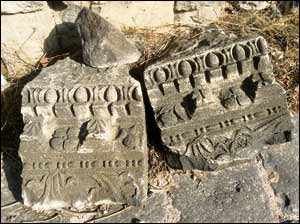 | ||
| Kibbutz members launched a daring night-time raid | ||
PERCHED 350 metres overlooking the eastern shore of the Sea of Galilee, above the 1937-founded kibbutz of Ein Gev, are the remains of the city of Hippos, also known as Susita, founded during the Hellenistic period in the second century BCE.
Originally settled by pagans, who later converted to Christianity, a small Jewish community is known to have also settled at Susita. It is just a short distance from another archaelogical site where an amazing reconstruction of an ancient synagogue is underway — one of 25 ancient synagogues already discovered on the Golan. Known as Umm el Kanatir (Mother of the Arches), the synagogue and other buildings at this site were built from black basalt stone. The remains of Susita are spread across a diagonally-shaped hill with an extensive plateau. Visitors are treated to the sight of scores of carved ornate stones and pillars that have been excavated and restored, with others waiting their turn. One of the first archaeological artifacts of importance one sees is an extremely sophisticated water system. Archaeologists are still working on uncovering Roman soldiers quarters and steam bathhouses.
“Some 30 members of the kibbutz took Susita during a night-time operation from the Syrian soldiers that were here and it became a front-line military command post until the war of 1967,” explained British-born guide James McKeever, who made aliya seven years ago. “The kibbutzniks carried out a three-pronged attack, one of which came up directly from below in the centre and caught the attention of the Syrians, but at the same time the other two groups came up from either side and thus overran the soldiers stationed there.” Looking across the Kinneret, to the right of Susita, a strange shaped hill holds a commanding position over the area, which James said, is the marker for the 1916 Sykes-Picot Agreement between the British and French. Upon entering Susita, apart from the remains of the city’s main gate, a guard post built by the kibbutz members comes in to view, perched over ancient basalt pipes that were part of a 25 kilometre long aqueduct. Just a few metres from that sits a portion of the rusty fence and minefield warning signs. “Members of the kibbutz, not the IDF, kept this position, the most eastern position, from 1948 until 1967,” explained James. Present day Ein Gev is a picturesque kibbutz, attracting tourists, both Israeli and from overseas. Famous for its fish restaurant and excursions on the waters of the Kinneret, a pleasant lakeside promenade has been developed in the name of one of Ein Gev’s founder members who later became the mayor of Jerusalem from 1965-1993, Teddy Kollek.
|
 FASCINATING: British-born Israeli tour-guide James McKeever with one of the sights in the Golan’s Susita-Hippos National Park
FASCINATING: British-born Israeli tour-guide James McKeever with one of the sights in the Golan’s Susita-Hippos National Park ANCIENT HISTORY: Some of the stones waiting to be restored
ANCIENT HISTORY: Some of the stones waiting to be restored